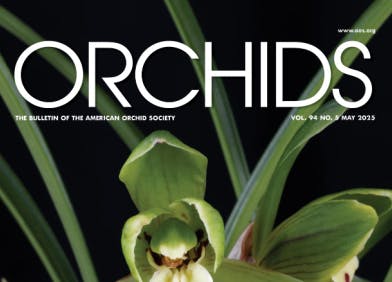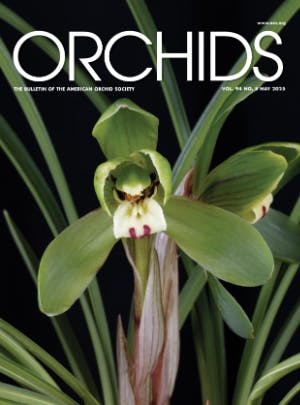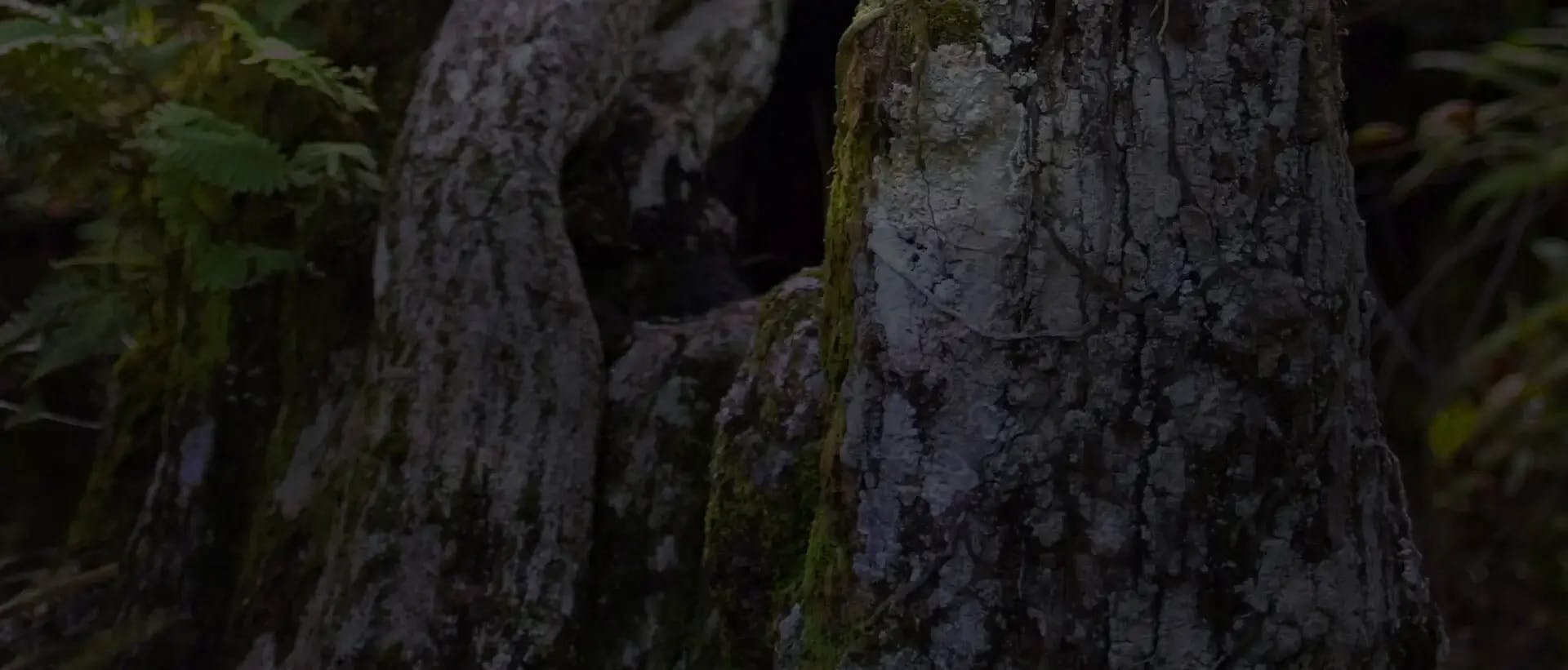
CYMBIDIUM GOERINGII is particularly beloved by many East Asian orchid enthusiasts. These unifloral, ensiform–leaved orchids symbolize nobility and dignity, which makes them popular as gifts while also showcasing aesthetic beauty in their unique colors and shapes in both flower and leaf. In particular, Cymbidium goeringii ‘Cheon–jong,’ meaning “heavenly seed,” is one of the most acclaimed varieties among orchid lovers in South Korea, China, and Japan. Unlike the wild type, this cultivar features shorter leaves and rounded sepals and petals with striking golden stripes, which induced some orchid lovers to pay hundreds of thousands of dollars during its peak popularity. Although general orchid care guidelines from the American Orchid Society are still applicable, cultivating Cymbidium goeringii in cooler climates requires attention to several key practices for success.
[1] Cymbidium goeringii ‘Cheon–jong’

POTTING MEDIUM Successful
Cymbidium goeringii cultivation begins with selecting the proper potting medium. The medium should be lightweight, pH–neutral, moisture–retentive and well–draining with good aeration. Among many options, a mixture of volcanic stones fulfills these requirements, typically comprising 50 percent Hyuga pumice, 30 percent Kanuma soil and 20 percent perlite and hard pumice. These granular materials are porous, stable and available in customizable particle sizes: fine grain (0.04–0.12 inches [1–3 mm]), small grain (0.12–0.24 inches [3–6 mm]), medium grain (0.31–0.59 inches [8–15 mm]) and large grain (0.47–0.98 inches [12–25 mm]). Before using the soil, rinse it to remove fine dust and impurities that could block drainage or aeration. When potting, position the pseudobulb base level with the pot’s top rim. Layer large, medium and small grains in descending order from bottom to top, then create a small mound around the pseudobulb using fine grains. This structure promotes efficient drainage and uniform drying along the height. The small mound on top also enables better moisture control, which will be discussed later.
[2] Although black orchid pots are the most common, translucent pots such as this one allow the grower to easily see the three grain–size layers in the pot and the mound on top.

LIGHT
Healthy plant growth relies on adequate light for photosynthesis, which requires a balance of light, water and air. Allow your Cymbidium goeringii to receive as much sunlight as possible year–round, provided temperatures remain below 104 F (40 C). If temperatures exceed 104 F (40 C) in summer, partially shade the plants to minimize the loss of photosynthesis efficiency. Many growers hesitate to provide direct sunlight due to the fear of light–induced burns on leaves. However, I believe most leaf damage results from underlying disease rather than sunlight exposure, as long as plants are acclimated to high light levels slowly. When a Cymbidium goeringii was intentionally exposed to excessive sunlight, sunlight–induced burning typically began with chlorophyll bleaching, where leaves faded from deep green to pale green. Near latitudes around 35 degrees (a line in the US running from just north of Santa Maria, California, through Texas and along the Georgia–North Carolina border), Cymbidium goeringii rarely experiences leaf burns, even in hot summers, if this shading technique is followed. Cymbidiums exposed to ample sunlight develop tougher, thicker and shorter leaves that arch gracefully — an aesthetically preferred feature among enthusiasts.
[3] Watering with a fine spray.

AIR CIRCULATION
Proper air circulation is another essential element in successful Cymbidium goeringii cultivation. Air circulation reduces the risk of overwatering and consequent disease. Since Cymbidium goeringii roots tend to be denser in pots compared to other species, stagnant air can easily trigger fungal and bacterial infections. Continuous gentle airflow is recommended, even though it accelerates moisture loss. On windy days, open greenhouse windows to allow natural airflow; on calmer days, use fans for ventilation. To optimize air circulation, keep upper windows closed and lower windows open to create an upward draft. Avoid pointing fans directly at the plants, as strong winds can force stomata to close, limiting carbon dioxide absorption. Close windows and turn off fans only when outdoor temperatures drop below freezing, 32 F (0 C), but periodically exchange air to remove fungal spores, bacteria and mold.
[4] An unnamed Cymbidium goeringii cultivar showing chlorophyll bleaching and sunlight–burned leaves due to intentionally excessive light exposure.

WATERING
Watering is one of the most challenging aspects of Cymbidium goeringii care, as improper watering is a common cause of orchid mortality. The November 2024 issue of Orchids, the AOS magazine, emphasizes this issue. Cymbidium goeringii requires its medium to remain moist but not soggy, with pseudobulbs maintaining mild humidity between waterings. To meet this requirement, build the potting structure as described earlier. Water thoroughly by soaking the pot for at least 10 seconds with a fine spray. Monitor moisture levels by lifting the pot to assess its weight. The top mound will dry first, turning lighter in color, while the interior retains moisture. At this point, lightly mist the top mound to prevent the pseudobulb from drying completely. Ensure that misted water remains on the top mound and does not flow down into the pot interior. Repeat this practice until the interior dries enough to require thorough watering. Adjust the frequency based on light and air circulation, and avoid thorough watering during rainy or freezing weather. Misting alone may suffice in such conditions. With ample sunlight and consistent airflow, Cymbidium goeringii may need more frequent watering than other species, but diligence is required to balance humidity and avoid overwatering.
[5] Cymbidium goeringii ‘Cheon–jong’ after proper dormancy. Note the plump pseudobulbs and clean, hardened roots.

TEMPERATURE MANAGEMENT
Temperature is the most critical aspect of the growth cycle of Cymbidium goeringii but often requires the least intervention by the grower who lives near the latitude of Nashville, Tennessee and Raleigh, North Carolina. Allow your plants to adapt to their natural environment. They will adjust by modifying leaf length, width, and other characteristics. During the fall, temperatures will fluctuate between 35–75 F (2–24 C) during the day, while during winter they range from 20–45 F (–7–7 C). This gradual drop in temperature, with fluctuations throughout the day, is particularly crucial for Cymbidium goeringii. During this period, Cymbidium goeringii growth slows and the plants prepare for winter by producing antifreeze compounds such as carbohydrates, dehydrins and lipids. These compounds accumulate as temperature variations deepen and extend, which is crucial for flower spike development. Allow Cymbidium goeringii to adapt naturally to temperature fluctuations, intervening ONLY if temperatures drop below freezing. Sudden shifts should be avoided to prevent damage. During winter dormancy, the plants cease growth altogether and strengthen themselves for the next growing season. Without this period, inflorescences and growth may suffer.
[6] A section of root from a Cymbidium goeringii that underwent a proper dormancy period. Note the inner tissue is full of carbohydrates and lipids eventhough the outer surface suffered from a fungal infection (inset). The inner tissue remained unaffected and unpenetrated by the infection.

REPOTTING
Cymbidium goeringii requires regular repotting for healthy growth and blooming. The AOS website recommends repotting every two to three years, but more frequent repotting benefits propagation and overall health. Repotting twice a year — once in the spring and once in the fall — is advisable. Before the active growth season, ensure sufficient space in the potting medium for root expansion. Replace broken and compacted medium with fresh material and inspect roots and pseudobulbs for infections. During fall repotting, check the plant’s overall health and plan for blooming and propagation. Remove dried sheaths, spent leaves and debris to prevent infections. Use small, flexible tools like interdental or mascara brushes to clean around pseudobulbs without causing damage. While frequent repotting may cause temporary disruption, the long–term benefits for propagation and health outweigh the drawbacks.
[7] The author in his greenhouse..

To conclude, the love and affection we share with orchids go beyond simple admiration. They form the cornerstone of a fulfilling and enriching bond that uplifts both grower and plant. However, in today’s fast–paced world, it is easy to inadvertently provide excessive care, mistakenly believing it to be an expression of our devotion. This over–intervention, such as unnecessary watering or excessive use of heaters particularly during dormant seasons, can sometimes hinder rather than help. Cymbidium goeringii thrives when allowed to follow its natural rhythms, particularly during fall and winter. Providing a well–aerated potting medium, maintaining moderate humidity levels and ensuring proper airflow are essential, but they must be complemented by restraint in colder months. Let your Cymbidium goeringii experience temperature fluctuations, as these conditions promote dormancy and prepare them for vibrant growth in the coming season. By combining thoughtful care with an appreciation for their natural processes, we foster not only the growth of our orchids, but also a deeper connection with the quiet resilience of nature itself.
— Jaesun Ma has been dedicated to cultivating East Asian Cymbidium goeringii since 2015. He currently has about 600 pots in cultivation and is actively sharing his “ample sunlight in a cooler environment” cultivation strategy (email: jaesun.ma.cymbidiums@gmail.com).












